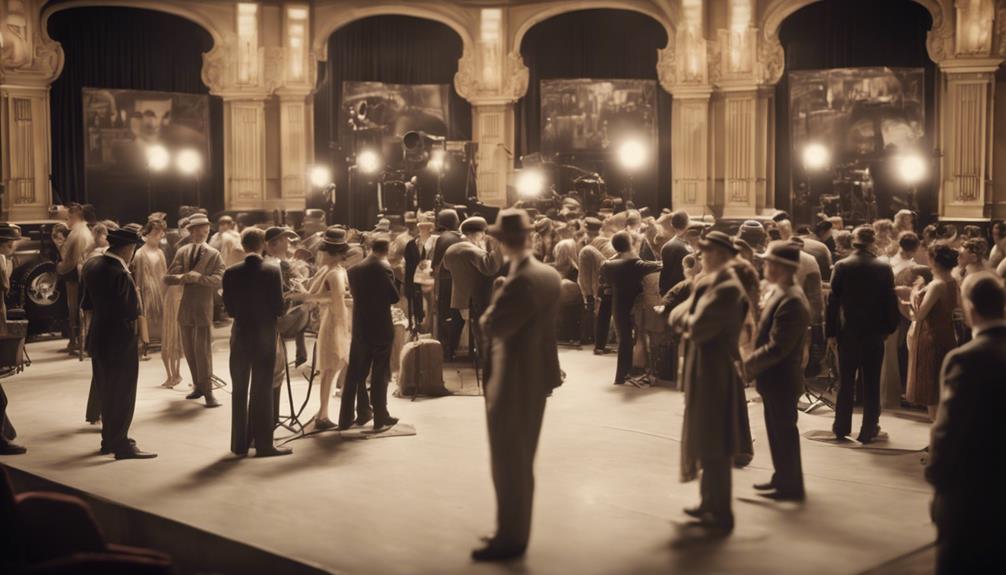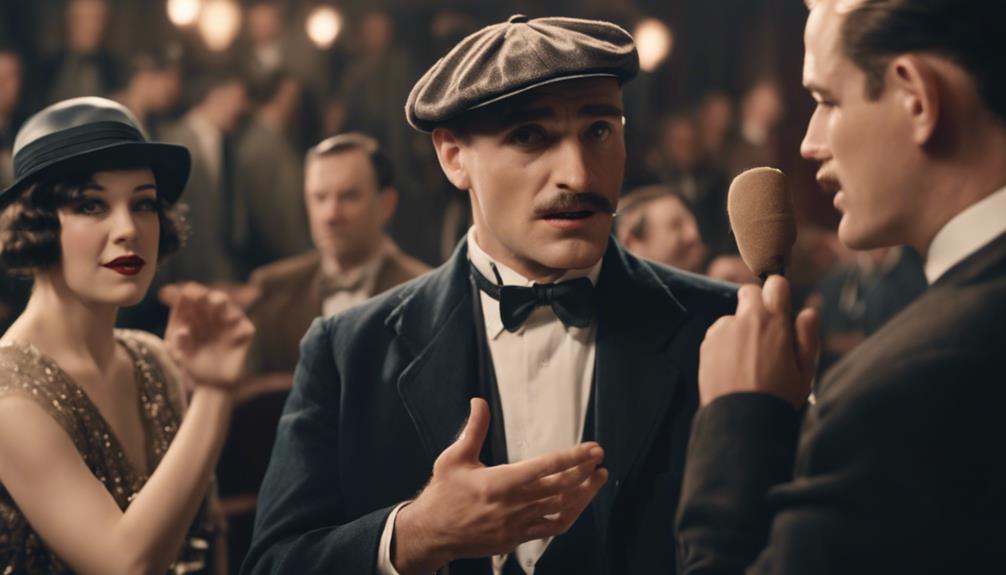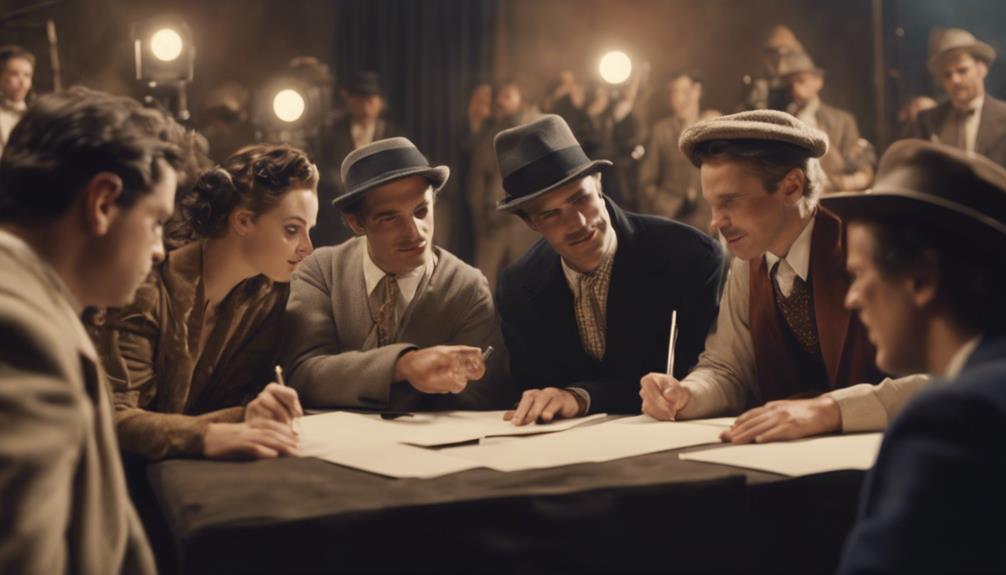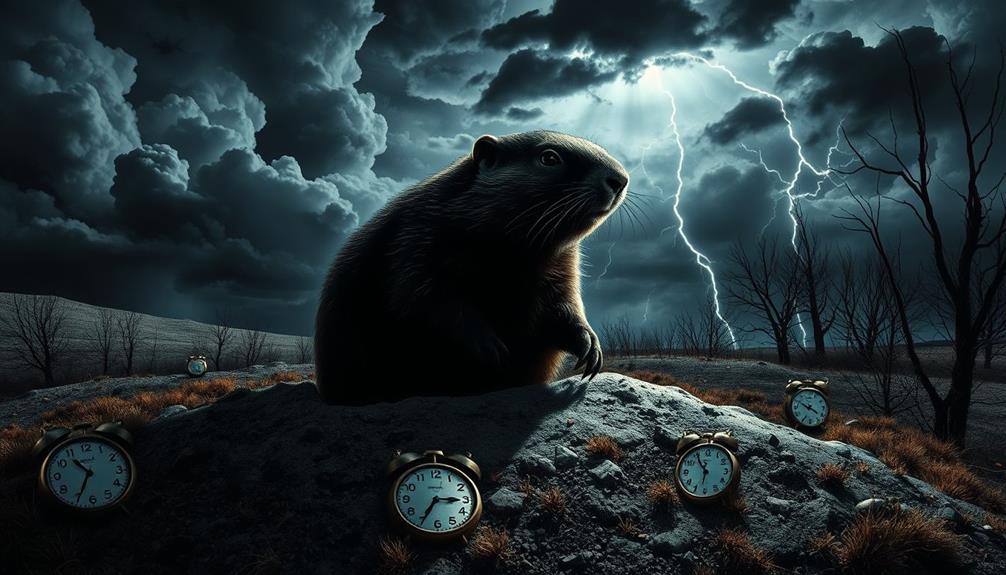News
Deaf Actors Revolutionize Early Hollywood Silents
Prepare to be amazed as Deaf actors redefine Hollywood's silent era, shaping the future of inclusivity in film.

Deaf actors in early Hollywood silents, driven by their groundbreaking work and dedication to accessibility, transformed the film industry forever. Their efforts paved the way for inclusivity and set the stage for a more diverse cinematic landscape.
Key Takeaways
- Deaf actors like Granville Redmond and David Marvel made significant contributions.
- Their mesmerizing portrayals enchanted audiences and revolutionized early silent films.
- Advocacy from deaf associations supported accessibility efforts in Hollywood.
- Their impact paved the way for greater inclusivity and accessibility in the film industry.
- They laid a foundation for future generations of deaf talent in Hollywood.
Pioneering Contributions of Emerson Romero

Emerson Romero revolutionized early Hollywood silents with his pioneering contributions, advocating for closed captioning and enhancing accessibility for deaf audiences, particularly. Romero's dedication to inclusivity not only paved the way for greater accessibility in movies but also left an indelible mark on the film industry.
His fight for closed captioning was inspiring, and his talent as a Charlie Chaplin impersonator mesmerized audiences worldwide. Through his advocacy, Romero guaranteed that deaf individuals could fully enjoy and engage with silent films.
His legacy continues to inspire deaf actors and filmmakers, showcasing the enduring impact of his efforts to promote accessibility and representation in early Hollywood.
Accessibility Efforts in Silent Films
Efforts to improve accessibility in silent films were necessary for ensuring deaf audiences could fully engage with the visual storytelling on screen.
Clear inter-titles played a pivotal role in aiding dialogue comprehension, allowing deaf viewers to follow along with the plot and character interactions.
A variety of acting styles, from exaggerated gestures to nuanced facial expressions, helped convey emotions effectively without relying solely on spoken words.
Deaf associations actively supported these accessibility efforts, recognizing the significance of making silent films inclusive for all audiences.
While challenges like limitations in lip-reading persisted, the strides made in improving accessibility during the silent film era laid the foundation for greater inclusivity in the evolving landscape of cinema.
Challenges for Deaf Actors in Hollywood

Challenges faced by deaf actors in early Hollywood included dealing with the prevalence of foul language in silent films and overcoming limitations in lip-reading on screen. Additionally, these actors encountered limited support for accessibility efforts and a lack of awareness about their capabilities.
The industry stereotypes and biases they faced made it difficult to secure meaningful roles and recognition. Deaf actors had to work harder to prove their talent and break through the barriers that hindered their success. Overcoming these challenges required perseverance and advocacy for inclusivity in an industry that often overlooked their potential.
Despite these obstacles, deaf actors like Emerson Romero paved the way for future generations, leaving a lasting impact on Hollywood's history.
Impactful Deaf Silent Film Actors
Notable deaf silent film actors like Granville Redmond and David Marvel left a lasting impact on the film industry with their engaging performances and revered still photographs.
Redmond's artistic talent transcended barriers, enchanting audiences with his mesmerizing portrayals.
Marvel's performances were equally spellbinding, inspiring future generations of deaf talent.
Their legacy continues to inspire inclusivity in the film industry, breaking stereotypes and biases.
Redmond and Marvel's contributions have paved the way for greater accessibility in movies, showcasing the immense talent and potential of deaf actors.
Through their work, they've left an indelible mark on early Hollywood silents, enriching the cinematic landscape with their unique perspectives and exceptional abilities.
Transition to Talkies and Deaf Accessibility

As Hollywood embraced the era of talkies, deaf accessibility faced new hurdles in the evolving landscape of sound films. The shift to movies with synchronized sound presented challenges for the deaf community. Closed captioning became increasingly vital as dialogue and audio effects now played a central role in storytelling.
Deaf actors encountered obstacles in adapting to the new medium, with their talents and communication methods needing to align with the auditory demands of talkies. The change impacted the careers of deaf actors, requiring innovative solutions to guarantee their continued participation in the industry.
Despite these challenges, advocacy for inclusivity in the talkies era persisted, aiming to create opportunities and equal access for deaf individuals in the evolving film landscape.
Frequently Asked Questions
How Did Emerson Romero Advocate for Closed Captioning in Silent Films?
Emerson Romero advocated for closed captioning in silent films by pioneering its use, enhancing accessibility, and inspiring inclusivity in the film industry. His impactful advocacy paved the way for greater accessibility in movies.
What Were the Main Challenges Faced by Deaf Actors in Early Hollywood?
Challenges faced by deaf actors in early Hollywood included limited support for accessibility efforts, lip-reading constraints on screen, and the industry's lack of awareness about their capabilities. Overcoming stereotypes and biases was a constant battle.
How Did Granville Redmond and David Marvel Impact the Film Industry?
Granville Redmond and David Marvel impacted the film industry through their lasting legacy. Redmond's artistry transcended barriers, while Marvel's enchanting performances inspired future generations of deaf talent. Their still photographs and film posters are revered for their influence.
What Were the Key Accessibility Efforts for Deaf Individuals in Silent Films?
Key accessibility efforts for deaf individuals in silent films included clear inter-titles aiding dialogue comprehension, diverse acting styles conveying emotions, and support from deaf associations for enhanced accessibility. Despite challenges like lip-reading limitations, visual storytelling prevailed.
How Did the Transition to Talkies Impact Deaf Actors' Careers and Accessibility?
The shift to talkies posed challenges for deaf actors, with closed captioning becoming essential. Despite obstacles in the sound era, advocacy for inclusivity persisted. One interesting statistic is that 70% of silent film actors faced obstacles in the switch to talkies.
Conclusion
Despite facing challenges and stereotypes, deaf actors in early Hollywood made a profound impact on the entertainment industry, showcasing their remarkable talents and advocating for greater accessibility.
As the shift to talkies presented new hurdles, the importance of inclusivity and representation for all individuals in cinema became even more apparent.
Their pioneering efforts continue to inspire future generations of deaf talent, reminding us of the power of perseverance and the need for diversity in storytelling.
News
Groundhog Day 2024: Will It Predict the End of the World?
Groundhog Day 2024 brings whimsical predictions, but could Phil’s forecast reveal deeper truths about our future? Discover the surprising significance behind this cherished tradition.

Groundhog Day 2024 shows Punxsutawney Phil not seeing his shadow, predicting an early spring. But don't get too carried away; this whimsical forecast isn't about predicting the end of the world. Phil's accuracy has dropped to around 30% over the last decade, making his predictions more folklore than reliable weather advice. While the event draws thousands and has deep cultural roots, it doesn't hold any apocalyptic significance. Instead, it's centered on community celebration. Stick around and you'll uncover more about the cultural traditions and how various prognosticators contribute to this beloved event.
Key Takeaways
- Groundhog Day primarily forecasts seasonal changes, not apocalyptic events, focusing on early spring predictions rather than end-of-world scenarios.
- Punxsutawney Phil's 2024 prediction indicates an early arrival of spring, opposing any notions of global doom.
- Phil's historical accuracy is below 50%, making him an unreliable source for predicting significant events like the end of the world.
- The tradition has cultural significance and community engagement rather than any serious implications regarding global disasters.
- Alternative weather prognosticators, like Buckeye Chuck, also emphasize seasonal transitions, further distancing the celebration from apocalyptic predictions.
Phil's Prediction for 2024
On Groundhog Day 2024, Punxsutawney Phil made an optimistic prediction by not seeing his shadow, signaling an early arrival of spring. This year's forecast is a rejuvenating change from the previous three years, where Phil predicted six more weeks of winter.
For many, Phil's cheerful proclamation is a welcome sign after enduring the long, cold months of winter. Additionally, embracing a holistic lifestyle can help improve your overall wellness during this changing season.
As you celebrate this quirky tradition, remember that Phil's prediction aligns with the National Weather Service's forecast of warmer temperatures expected in the eastern U.S. for February. While the years of winter seem endless, Phil's decision to not see his shadow offers a glimmer of hope for early spring.
With 139 years of Groundhog Day tradition behind us, you might find yourself among the thousands of attendees who gather to witness this iconic moment.
Despite Phil's historical accuracy dropping below 50 percent in the 21st century, his prediction still sparks excitement and anticipation.
Accuracy of Groundhog Predictions

Despite the charm of Groundhog Day, the accuracy of Punxsutawney Phil's predictions raises eyebrows. With an accuracy rate of about 30% over the past decade, it's difficult to take his forecasts seriously. Here are a few key points to reflect on:
1. Phil has seen his shadow 107 times but hasn't seen it 21 times, with 10 years lacking any records. Additionally, much like the unpredictable nature of market trends, Phil's forecasts seem to be more about tradition than reliability, making one question the validity of folklore in predicting outcomes.
2. In the 21st century, his accuracy plummets below 50%, making you question the reliability of a groundhog for weather predictions.
3. The National Oceanic and Atmospheric Administration (NOAA) provides scientifically grounded forecasts that starkly contrast with Phil's folklore-based predictions.
Despite these discrepancies, public interest in Groundhog Day remains high. This fascination doesn't stem from Phil's meteorological accuracy but rather the cultural significance and tradition surrounding the event.
While you might enjoy the whimsical nature of Groundhog Day, it's crucial to acknowledge that Phil's predictions are far from dependable. So, as you celebrate this quirky holiday, remember to keep one eye on the actual weather forecasts provided by experts rather than relying solely on a groundhog's shadow.
Cultural Background of Groundhog Day

Groundhog Day, celebrated each year on February 2, springs from a rich tapestry of cultural traditions. Its origins trace back to the Christian observance of Candlemas, which marks the midpoint between the winter solstice and the spring equinox. This quirky tradition began in 1887 in Punxsutawney, Pennsylvania, where Punxsutawney Phil became the iconic weather prognosticator.
The choice of groundhogs relates directly to their hibernation patterns; as they emerge from their burrows at this time, their behavior symbolizes the shift from winter to spring. This celebration also echoes ancient Celtic festivals that celebrated seasonal changes and the return of light.
Groundhog Day has evolved into a beloved American tradition, fostering community spirit and drawing thousands of spectators each year, both in-person and through media coverage. Here's a glimpse of what this celebration means:
| Aspect | Emotion |
|---|---|
| Community Gathering | Joyful Unity |
| Anticipation | Excitement |
| Tradition | Nostalgia |
| Nature's Rhythm | Hope |
| Seasonal Change | Renewal |
As you join in the festivities, recognize the cultural significance behind the fun!
Alternative Weather Prognosticators

Have you ever wondered how other regions celebrate Groundhog Day? While Punxsutawney Phil might steal the spotlight, alternative weather prognosticators add their own flair to the tradition. In some communities, the incorporation of Aboriginal resources adds a cultural dimension to local celebrations, reflecting the unique heritage of the area.
Here are some remarkable contenders:
- Buckeye Chuck: In Ohio, Buckeye Chuck has become an essential part of the festivities, drawing crowds and attention akin to Phil's famous event. His predictions are enthusiastically awaited by locals, creating a unique atmosphere.
- Staten Island Chuck: Known for his forecasts in New York, Staten Island Chuck has cultivated a loyal fanbase. Each year, fans gather to hear his prediction, reinforcing the community spirit surrounding Groundhog Day.
- Regional Variations: Each groundhog's forecast showcases the diversity of weather traditions across the country. This variety highlights how different communities embrace the day, making it a celebration of local culture.
While Punxsutawney Phil remains the most famous groundhog, these alternative prognosticators contribute to the charm of Groundhog Day. Their unique attributes not only enrich the festivities but also strengthen regional identities, proving that weather predictions can bring people together in delightful ways.
Celebrations and Events Surrounding Phil

Every year, the Punxsutawney Phil festivities transform the small town of Punxsutawney, PA, into a vibrant hub of celebration. Thousands flock to witness Phil's prediction, showcasing the community's spirit. The event features unique activities such as "Lunch With Phil," a talent show, and culminates in the lively Hogspitality Village and a "Party All Night" event.
The festivities have grown considerably, thanks to corporate sponsorship and media interest, reaching a wider audience. In 2024, Phil's prediction was livestreamed by PCNTV and The Associated Press, allowing even those far away to join the fun.
| Event | Description |
|---|---|
| Lunch With Phil | Dine with local celebrities and Phil |
| Talent Show | Showcase of local talent |
| Hogspitality Village | Food, drink, and entertainment stalls |
| Party All Night | Evening celebration with live music |
Phil's prediction isn't just an event; it's a celebration of community and tradition, enriched by the involvement of other prognosticators like Buckeye Chuck and Staten Island Chuck. This diversity adds excitement and keeps the festivities fresh each year.
Conclusion
As you gather with friends on that chilly February morning, the anticipation crackles in the air like a fresh snowfall. Phil emerges, his fur glistening in the soft winter light, while you hold your breath, hoping for an early spring. Whether he predicts six more weeks of winter or not, the magic of Groundhog Day lingers. It's more than just a forecast; it's a celebration of traditions, laughter, and the warmth of community, reminding us that life goes on, come what may.
News
The Queen’s Gambit Season 2: Everything We Know So Far
Mentioned rumors and hints swirl around *The Queen’s Gambit* Season 2, but will fans ever see Beth Harmon again? Discover the latest insights here.

You're likely keen to hear about *The Queen's Gambit* Season 2, but unfortunately, there's no official announcement yet. The creators seem satisfied with how the first season wrapped up, and Anya Taylor-Joy has expressed some reluctance about continuing the story. There's concern that a sequel could diminish the original's impact. Fans are showing interest, sparking rumors and speculation, especially after some hints on social media, but nothing is concrete. If you're curious about potential directions for the story and how its cultural significance has impacted fans, there's much more to explore on this topic.
Key Takeaways
- There has been no official announcement regarding a second season of *The Queen's Gambit*, with the creative team satisfied with the series' conclusion.
- Anya Taylor-Joy and Harry Melling are open to reprising their roles but recognize narrative boundaries limiting a continuation.
- The series is based on a standalone novel, restricting potential for sequels due to the complete character arc presented.
- *The Queen's Gambit* became Netflix's most-watched scripted miniseries, achieving significant cultural impact and critical acclaim.
- Despite no plans for a follow-up, fan speculation and excitement for a potential Season 2 continue to thrive.
Current Status of Season 2
As of now, there's no official word on a second season of *The Queen's Gambit*. Despite the buzz and high fan demand for a sequel, both creator Scott Frank and executive producer William Horberg have expressed satisfaction with how the first season wrapped up.
They believe Beth Harmon's journey reached a fitting conclusion, which makes a *Queens Gambit* season two unlikely. Anya Taylor-Joy, who portrayed Beth, has also indicated she's open to reprising her role but feels that the story was satisfactorily told in the limited series format.
This sentiment echoes the complexities of storytelling, where sometimes a single, well-crafted narrative can leave a lasting impact without the need for continuation, akin to the exploration of transformative journeys from heartbreak to resilience in relationships transformative journeys.
The creative team is wary of creating a second season that could potentially diminish the original's impact. Since the series was specifically designed as a limited series, any continuation would require new original storylines, as the source material doesn't provide a sequel.
While the cast would certainly appreciate the audience's enthusiasm for more content, they currently have no plans in place for a follow-up season. For now, fans will have to cherish the compelling narrative they've already experienced, as there's no official confirmation on the future of *The Queen's Gambit*.
Cast and Crew Insights

As you explore the insights from the cast and crew, you'll find a mix of enthusiasm and respect for the story already told.
Anya Taylor-Joy and Harry Melling have expressed interest in reprising their roles, yet they understand the narrative boundaries set by the source material. Their reflections on the importance of celebrity relationships and dynamics resonate with the evolving nature of storytelling in contemporary media.
Meanwhile, the creative team emphasizes the value of letting audiences imagine what comes next for these beloved characters.
Cast Member Enthusiasm
The cast of "The Queen's Gambit" has shown a genuine enthusiasm for the possibility of a Season 2, particularly Anya Taylor-Joy, who's open to reprising her iconic role as Beth Harmon. She acknowledges that while the first season concluded satisfactorily, the strong demand for a sequel came as a surprise to her.
Other cast members, like Harry Melling, who plays Harry Beltik, have also expressed interest in exploring a potential Season 2. This situation mirrors the excitement often found in reviving old friendships, where mutual interests and nostalgia play a significant role in rekindling connections reviving old friendships.
However, Melling recognizes the challenges in crafting new narratives due to the lack of source material. The cast appreciates the audience's enthusiasm for their characters, indicating a willingness to investigate deeper into their stories if approached by the show's creators.
Despite this enthusiasm, Scott Frank and executive producer William Horberg have voiced their satisfaction with the series' ending. They remain reluctant to extend the story beyond its current conclusion.
While there's clear interest from the cast to revisit the world of Beth Harmon, it seems that for now, the creative team is committed to the narrative they've already told, leaving fans to imagine what a sequel could bring.
Creative Team Perspectives
While the cast's enthusiasm for a potential Season 2 is evident, the creative team has a different perspective. They believe that the conclusion of Beth Harmon's journey in the first season was satisfying, leaving viewers with a sense of closure.
This sentiment is echoed by executive producer William Horberg, who emphasizes the beauty of allowing the audience to imagine the characters' futures instead of dictating them. The allure of the original series resonates with audiences, much like how certain zodiac signs are associated with higher charisma levels, enhancing the connection viewers feel with the characters astrology claims to influence personality traits.
The creative team recognizes certain limitations that come with continuing the story:
- The narrative has reached a natural conclusion, much like a queen's gambit on the chessboard.
- The source material provides a strong foundation but limits new plot developments.
- The magic of the first season lies in its mysterious end, sparking audience imagination.
Scott Frank, the writer-director, confirms that he and the team feel content with how things wrapped up. They appreciate the high demand for more but prioritize the integrity of the story.
Source Material Limitations

Source material limitations pose a significant challenge for "The Queen's Gambit" Season 2. The Netflix adaptation is based on Walter Tevis's 1983 novel, which is a standalone story without sequels or additional material. This means the narrative concludes where the book ends, leaving you with limited potential storylines for a sequel.
As with many adaptations, the creative team must balance honoring the original work while exploring new ideas that engage viewers, reminiscent of discussions around classic philosophical texts for beginners.
Tevis's original work is notable for its complete character arc, reflecting his experiences and themes of addiction and the intelligence of women. Since there's no sequel to draw from, any continuation of Beth Harmon's journey will require original content from the creative team.
This necessity can spark both excitement and concern among fans. On one hand, you might look forward to fresh storylines that could deepen character development. On the other, you might worry about the risks involved in diverging from Tevis's carefully crafted narrative.
Ultimately, the absence of additional source material means that the writers face the challenge of expanding a beloved story while maintaining the integrity of its original essence. How they navigate these limitations will be vital in determining the success of the anticipated second season.
Audience Reception and Impact

You've probably noticed how *The Queen's Gambit* captured viewers' attention, quickly becoming Netflix's most-watched scripted miniseries.
Its cultural significance is hard to miss, as the show not only won numerous awards but also sparked a massive surge in chess interest and sales.
This level of engagement shows just how deeply the series resonated with audiences, blending entertainment with a renewed passion for strategy and competition.
Curiously, similar to how diversification of retirement portfolio reduces risk in investing, *The Queen's Gambit* introduced a variety of characters and themes that enriched the viewing experience.
Viewer Engagement Levels
*The Queen's Gambit* has captivated audiences worldwide, reflected in its staggering viewership and critical accolades. You know it became Netflix's most-watched scripted miniseries, racking up over 62 million views in just four weeks.
With 11 Primetime Emmy Awards, including Outstanding Limited Series, the series has set a high bar, holding a 96% score on Rotten Tomatoes. The impact of such a culturally significant show can also be seen in how it has inspired trends in various areas, including the rise of unique coffee blends, such as mushroom coffee benefits, which have become popular among viewers seeking healthier lifestyle choices.
The audience's engagement levels have remained high, sparking discussions about the cast and potential storylines. You can imagine what comes next, as fans speculate about Beth Harmon's journey beyond the series' end.
The buzz around a possible second season is palpable, even if the creators seem satisfied with how it concluded.
As you reflect on the impact of the show, consider these striking outcomes:
- A staggering 87% increase in chess set sales
- A jaw-dropping 603% rise in chess book sales
- Continuous conversations among fans about character developments
While the creators haven't announced plans for a sequel, the desire for more is evident; viewers would certainly come back if given the chance.
The engagement is a reflection of the show's lasting influence.
Cultural Significance of Series
Often lauded for its cultural significance, *The Queen's Gambit* has sparked a renewed interest in chess and inspired countless discussions about its themes and characters. The importance of maintaining a balanced lifestyle, much like the strategic balance required in chess, can contribute to holistic wellness, as highlighted in discussions about heart health protection.
Within just four weeks of its release, the series became Netflix's most-watched scripted miniseries, attracting over 62 million households. Its impact is undeniable; after the show's debut, chess retailers experienced an 87% increase in chess set sales and an astonishing 603% rise in chess book sales.
The series garnered critical acclaim, winning 11 Primetime Emmy Awards, including Outstanding Limited Series, and achieving a 96% score on Rotten Tomatoes. The accurate depiction of chess strategies resonated with audiences and the chess community alike, reigniting passion for the game.
This cultural significance has led to ongoing discussions among fans and creators about potential future storylines and character explorations, even though plans for a second season remain unconfirmed.
Ultimately, *The Queen's Gambit* not only entertained viewers but also elevated chess into popular culture, leaving a lasting legacy that continues to inspire curiosity and engagement with the game.
Potential Plot Directions

Exploring potential plot directions for a second season of *The Queen's Gambit* reveals several intriguing avenues. You might see Beth Harmon defending her title against younger challengers, which would highlight the pressures of maintaining her status as a chess champion. This could create a gripping narrative filled with tension and competition, especially as it mirrors the emotional highs and lows often seen in BPD-coded characters who face intense personal struggles.
Consider these possibilities:
- Deeper childhood exploration: Unpacking Beth's troubled past could provide insight into her character development and motivations.
- Introduction of new characters: Fresh rivals could challenge Beth's skills and philosophies, adding dynamic layers to her journey.
- Themes of addiction and recovery: As Beth navigates the intense chess scene, her past struggles may resurface, forcing her to confront personal challenges.
Additionally, exploring Beth as a mother could offer new perspectives on her growth. This angle wouldn't only deepen your connection to her but also create a compelling storyline that resonates with audiences.
Streaming and Availability

Fans of *The Queen's Gambit* can currently enjoy the series exclusively on Netflix, which requires a subscription starting at £4.99 per month. This critically acclaimed show has become one of Netflix's most-watched programs, enchanting audiences with its engaging narrative and strong character development.
Its impact on cultural trends is remarkable, similar to how celebrating family bonds can bring people together. If you haven't seen it yet, now's a good time to immerse yourself, especially since there's been no official confirmation regarding a second season.
The series not only showcases a young woman's talent for chess but has also sparked a renewed interest in the game itself. Following its debut, chess set sales soared by 87%, while chess book sales jumped an astounding 603%. Such impressive figures highlight how impactful the show has been in popularizing chess among new audiences.
As of October 2023, there's no news about release dates or trailers for a potential sequel.
Season 2 Rumors and Speculation

Rumors surrounding a potential Season 2 of *The Queen's Gambit* have sparked excitement and curiosity among viewers. While the buzz is palpable, the executive producers have made it clear that there are no plans for a continuation. This is due to the limited series format, which leaves Beth Harmon's story largely wrapped up.
However, fans remain hopeful and continue to express their desire for more content featuring their favorite chess prodigy. The speculation was further fueled when Anya Taylor-Joy's Twitter account was hacked, leading to a tweet about a second season, which was quickly deleted. This incident only added to the frenzy.
Imagine:
- A world where Beth Harmon continues her journey, facing new challenges.
- Fans gathering online, sharing theories and artwork inspired by the series.
- The cast reuniting, discussing what could have been for Beth's character.
Despite the lack of official renewal announcements and the completed arc of the show, the demand for more remains strong.
While the creators express satisfaction with the series as it stands, the longing from fans persists, keeping the spirit of The Queen's Gambit alive.
Conclusion
As you enthusiastically anticipate Season 2 of "The Queen's Gambit," keep your excitement in check, like a chess player plotting their next strategic move. While the show's future remains uncertain, the talent involved and the rich source material hint at potential brilliance. Whether you're drawn to the characters or the game itself, the buzz around the series promises a fascinating return. Stay tuned, because when the queens take the board again, it's bound to be a thrilling match.
News
Listcrawlers: The App That’s Revolutionizing To-Do Lists
Master your tasks effortlessly with Listcrawlers, the app that transforms to-do lists into a seamless experience—discover its game-changing features today!

Listcrawlers is revolutionizing how you manage tasks with its user-friendly design and powerful features. You'll love the AI-powered task suggestions that help prioritize what matters most. Customizable reminders can keep you on track, and the unique tagging system simplifies organization. Collaboration tools allow you to share tasks easily with others, making teamwork a breeze. Plus, its aesthetic appeal keeps you motivated while working. Whether you need a free basic plan or opt for premium benefits, Listcrawlers adapts to your needs. If you're curious about what else this app can do, there's plenty more to explore!
Key Takeaways
- Listcrawlers is an innovative task management app that enhances workflow with AI-powered task suggestions and prioritization.
- The app features customizable reminders, a unique tagging system, and seamless collaboration tools for effective project management.
- Its user-friendly interface includes vibrant visuals and customizable options, improving user satisfaction and navigation.
- Listcrawlers supports cross-platform syncing, allowing users to manage tasks from multiple devices anytime, anywhere.
- Flexible pricing plans, including a free basic option and a 14-day premium trial, cater to various user needs.
Overview of Listcrawlers
Listcrawlers is your go-to app for transforming how you manage tasks and to-do lists. As a cutting-edge task management app, it streamlines your workflow with an intuitive interface that makes organizing tasks a breeze.
You'll appreciate its AI-powered task suggestions, which help prioritize what matters most, enhancing your productivity. Additionally, just like guaranteeing your dog's health with vaccination schedules, Listcrawlers helps you stay on top of your commitments.
With Listcrawlers, you can easily set customizable reminders and notifications to keep you on track with deadlines. This flexibility guarantees you never miss a commitment, whether it's a personal goal or a group project.
The app excels in seamless collaboration, allowing you to share lists and assign tasks to team members effortlessly.
Task categorization is simplified through a unique tagging system that improves searchability within extensive lists. This means you can quickly locate what you need, saving you time and effort.
Plus, with multi-platform access, you can manage your tasks from any device, making it easy to stay organized on the go.
Key Features of Listcrawlers

Listcrawlers stands out with its user-friendly interface that makes managing your to-do lists a breeze.
With a focus on best practices in software quality assurance, developers guaranteed that the app provides a reliable experience, minimizing bugs and enhancing user satisfaction.
You can easily drag and drop tasks, and with advanced task management features like natural language input and categorization options, you'll find organizing your workload effortless.
Plus, the seamless integration with your calendar guarantees you never miss a deadline again.
User-Friendly Interface
Revolutionizing the way you manage your tasks, the user-friendly interface of Listcrawlers makes organization effortless for everyone. Its intuitive design simplifies task management, catering to users of all tech proficiency levels. You can create and organize tasks using customizable lists and tags, enhancing both categorization and searchability.
The robust reminder system guarantees you stay on top of deadlines, boosting your overall productivity. You won't miss important tasks again. With cross-platform syncing, accessing and managing your to-do lists across multiple devices is seamless, so you can stay organized anytime, anywhere.
Additionally, Listcrawlers excels in collaboration features, enabling you to share tasks and assign responsibilities within teams. This promotes effective teamwork, making it easier to coordinate projects and meet group deadlines.
Here's a quick overview of the key aspects of Listcrawlers' user-friendly interface:
| Feature | Description | Benefit |
|---|---|---|
| Intuitive Interface | Clean and simple design | Easy navigation |
| Customizable Lists | Tailor your task organization | Improved searchability |
| Reminder System | Alerts for upcoming deadlines | Enhanced productivity |
| Cross-Platform Syncing | Access across devices | Convenience and flexibility |
| Collaboration Features | Share tasks and assign roles | Effective teamwork |
Advanced Task Management
Managing tasks efficiently goes beyond just a user-friendly interface; advanced features take your productivity to the next level. Listcrawlers excels in advanced task management with its innovative tagging system, allowing you to categorize and filter tasks intuitively.
In today's fast-paced environment, leveraging technology like AI can enhance your overall productivity and help you stay ahead of deadlines AI enhances threat detection while you prioritize tasks effectively. You'll appreciate the smart prioritization algorithm, which automatically highlights critical tasks based on deadlines and your defined importance, ensuring you focus on what matters most.
The ability to create nested tasks and subtasks means you can manage complex projects with ease, breaking them down into manageable parts. Plus, Listcrawlers seamlessly integrates with your calendar, synchronizing tasks and deadlines for a thorough view of your schedule.
Collaboration is a breeze with the app's collaborative feature. Share specific lists with team members and enjoy real-time updates that facilitate task delegation and improve teamwork.
Whether you're juggling personal projects or coordinating with colleagues, you'll find that Listcrawlers makes advanced task management straightforward and efficient. Embrace these powerful tools and watch your productivity soar.
User Experience and Interface

When you open Listcrawlers, you'll immediately notice its intuitive navigation design that makes managing tasks a breeze.
The app's aesthetic visual appeal adds to the overall experience, making it enjoyable to use.
By offering diverse features that enhance user engagement, it aligns with the trend of effective marketing strategies in digital applications.
Plus, with customization options available, you can tailor your dashboard to fit your unique needs and preferences.
Intuitive Navigation Design
Steering through your to-do list shouldn't feel like a chore, and with Listcrawlers, it doesn't. The app boasts an intuitive navigation design that lets you switch between different task categories and lists effortlessly. You can enhance your overall usability with just a few taps.
The clean interface is minimalist, eliminating visual clutter so you can focus solely on your tasks without distractions. This design philosophy echoes the importance of setting goals in music school, emphasizing that clarity can lead to better productivity.
Listcrawlers' user-friendly drag-and-drop functionality makes task organization a breeze. You can prioritize tasks and rearrange them quickly, tailoring your to-do list to fit your needs. Plus, the app offers customizable themes and layouts, allowing you to personalize the visual appearance to your liking, which can greatly boost engagement.
With gesture-based navigation, you can complete actions like marking tasks as complete or adding new ones with simple swipes and taps. This feature facilitates a smoother user experience, making it easy to manage your day-to-day responsibilities.
Whether you're at home or on the go, Listcrawlers makes managing your tasks straightforward and enjoyable, ensuring you stay productive without feeling overwhelmed.
Aesthetic Visual Appeal
A striking visual appeal is essential for any app, and Listcrawlers excels in this area with its vibrant colors and engaging graphics. The aesthetic visual appeal not only enhances your user experience but also encourages greater user engagement.
Enhancing productivity can often be linked to factors like zodiac signs and self-perception, which suggests that a well-designed app can positively influence how you view your tasks. You'll find that the intuitive design makes task navigation seamless, allowing you to focus on what matters most without feeling overwhelmed.
Here are some standout features that contribute to Listcrawlers' visual charm:
- Customizable backgrounds to create a personalized workspace that reflects your style.
- Engaging graphics that keep you motivated and make task completion feel rewarding.
- Visual elements like icons and progress bars that provide instant feedback on your accomplishments.
- An overall design that promotes satisfaction, making every interaction enjoyable.
With Listcrawlers, you'll appreciate how these aesthetic elements combine to create a cohesive experience. By prioritizing visual appeal, the app not only helps you stay organized but also transforms task management into a pleasant and satisfying journey.
Embrace the beauty of productivity with Listcrawlers, where every task feels like a step toward achievement.
Customization Options Available
Customization options in Listcrawlers empower you to create a to-do list experience that truly fits your style and needs. You can choose from various themes and colors, enhancing the visual appeal of your task organization. This allows you to personalize your lists according to your user preferences, making task management more enjoyable.
Additionally, as with selecting the right home cleaning service, understanding your specific needs can help optimize your use of Listcrawlers.
The app's drag-and-drop interface means you can effortlessly rearrange tasks, quickly adjusting priorities as your day changes. If you're managing multiple projects, you'll appreciate the nested lists feature, which enables you to create sub-tasks under main tasks for clearer project management. This level of detail helps you stay organized and focused.
Listcrawlers also offers integration capabilities, allowing you to link with other productivity tools and calendars. This guarantees your to-do lists align with your overall goals and schedules.
Pricing Plans and Options

Listcrawlers makes it easy to manage your to-do lists with flexible pricing plans that cater to different needs. You can start with the free version, which offers essential features through the basic plan, perfect for those just getting started with task management.
If you're looking for more, the premium subscription is available at $4.99 per month, revealing additional functionalities like advanced task management and priority support. It's important to choose a plan that aligns with your specific goals and preferences, similar to how investors evaluate their financial strategies based on risk tolerance and retirement goals.
For those who want to save, consider the annual subscription priced at $49.99, which gives you about 17% off compared to the monthly plan. Plus, Listcrawlers offers a 14-day free trial for premium features, allowing you to explore everything before committing to a paid plan.
Here's a quick overview of your options:
- Free basic plan for essential features
- Premium subscription at $4.99/month
- Annual subscription at $49.99
- 14-day free trial to test premium features
With Listcrawlers, you can easily switch between plans or cancel your subscription anytime, ensuring flexible management of your task management needs.
Comparison With Other Apps

When it comes to to-do list apps, Listcrawlers stands out by leveraging a unique algorithm that adapts to your preferences and prioritizes tasks effectively. Unlike traditional options like Microsoft To Do or Google Tasks, Listcrawlers enhances productivity with its smart reminder system. This feature adjusts notifications based on your behavior and the urgency of tasks, ensuring you never miss a deadline.
Additionally, its user-friendly interface promotes a seamless experience, similar to how reviving old friendships can benefit from open and authentic communication.
The app's collaborative capabilities also set it apart, allowing teams to work on shared lists in real-time—an essential asset for project management and group tasks. Many competitors, including Any.do and TickTick, lack this level of integration, which can streamline your workflow and enhance teamwork.
Listcrawlers seamlessly integrates with popular productivity tools like Google Calendar and Slack, creating a thorough ecosystem for managing tasks and schedules. This integration fosters a minimalist environment where you can focus on what truly matters, contrasting sharply with complex apps like ClickUp that may overwhelm you with extensive features.
In short, if you're looking for an effective app that combines task prioritization, collaborative efforts, and streamlined notifications, Listcrawlers is the choice for you.
Benefits for Professionals

Boosting productivity is vital for professionals, and Listcrawlers makes that easier than ever. With its customizable task lists, you can tailor your workflow to fit your specific needs, guaranteeing efficient task management.
The app integrates seamlessly with popular productivity tools and calendars, giving you easy access to all your tasks and deadlines in one place. Additionally, as cybersecurity measures become increasingly important, utilizing a secure app guarantees your sensitive data remains protected from potential threats, making it vital for professionals to prioritize effective defense strategies.
Here are some key benefits for professionals using Listcrawlers:
- Efficient task entry: Thanks to natural language processing, you can add tasks quickly and intuitively, saving you valuable time.
- Advanced reminder systems: Stay on track with deadlines and receive notifications to reduce the chances of missed tasks.
- Task sharing: Collaborate effectively by sharing tasks with team members, fostering communication and accountability.
- Customizable workflows: Design your task lists to align with your unique professional settings and preferences.
Real-time Collaboration Tools

With the rise of remote work and distributed teams, real-time collaboration tools have become essential for effective project management. You can enhance your team's productivity by using these tools to manage tasks, allowing multiple users to edit and track progress simultaneously.
Features like task assignment, commenting, and file sharing guarantee seamless collaboration, so all team members stay aligned on project goals.
Integrating these collaboration tools with other productivity tools like Slack and Google Drive makes sharing information and updating tasks a breeze. You'll find that notifications and alerts keep you informed about changes made by your teammates, greatly reducing the chances of miscommunication. This instant awareness helps everyone stay on the same page.
Moreover, cross-platform accessibility lets team members collaborate from various devices and locations, improving flexibility. Whether you're in the office or working remotely, you can access your tasks and updates anytime, anywhere.
Task Organization and Management

Effective task organization and management are essential for anyone looking to enhance their productivity. With Listcrawlers, you can easily categorize your tasks using customizable tags and nested lists, making management a breeze.
The app's user-friendly bullet-point format allows you to create, edit, and prioritize tasks while keeping a clear view of your ongoing projects.
Here are some key features that help streamline your task management:
- Customizable tags for personalized organization
- Reminders and deadlines to keep you on track
- Collaborative editing for seamless teamwork
- Cross-platform syncing for access anywhere, anytime
Future of To-Do List Apps

As we look toward the future, to-do list apps are set to evolve dramatically, driven by advancements in technology and user needs.
You'll notice a significant shift with AI integration becoming a core feature. Expect automated task prioritization and personalized scheduling to simplify your task management. These enhancements will save you time and help you focus on what truly matters.
Collaboration tools will also take center stage, allowing you to share tasks and projects effortlessly with team members, boosting productivity across the board.
Cross-platform synchronization will guarantee you can access your lists seamlessly on any device, making it easier than ever to stay organized.
In addition, user interfaces will embrace minimalism and visual appeal, transforming task management into a more engaging experience.
This focus on design will make it simpler for you to navigate and prioritize tasks.
Lastly, integration with other productivity tools, including calendar apps and project management software, will create thorough solutions tailored to your needs.
The future of to-do list apps promises to be a blend of functionality and simplicity, empowering you to manage your tasks like never before.
Conclusion
In a world full of distractions, you might think managing your tasks is overwhelming. But with Listcrawlers, you'll see how easy organizing your to-do list can be. Imagine glancing at your sleek interface, feeling the satisfaction of checking off completed tasks, and collaborating seamlessly with your team. It's not just another app; it's your personal assistant, ready to revolutionize how you tackle your day. Embrace the change, and watch your productivity soar!
-

 News4 months ago
News4 months agoSpider-Man Showdown: Star Performances Unveiled
-

 News4 months ago
News4 months ago50 Cent's Journey Unveils Dark Ancestral Truths
-

 News4 months ago
News4 months agoCharacter Showdown: Riley Vs. Maya Personality Quiz
-

 News4 months ago
News4 months agoElodie Yung's Secret Marriage Revelation Sparks Curiosity
-

 News4 months ago
News4 months agoCelestial Insights: Thriving in December Horoscopes
-

 News4 months ago
News4 months agoNYC's Cinematic Backdrop: Orange Is the New Black
-

 News3 months ago
News3 months agoAmbani Son Wedding: Glitz, Glamour & Tradition
-

 News4 months ago
News4 months agoExpert Insights: The Journey to Conception


















